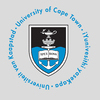A day in the life of the UCT television studio
30 March 2009 |
| Alan Johannes at work in the UCT television studio. |
Probably one of UCT's best-kept secrets, the television studio below the Baxter Theatre Centre is built to exacting British Broadcasting Corporation specifications, and is part of the Centre for Film and Media Studies. The studio was established in the late 1970s, probably the first television studio in Cape Town, and until 1980 the SABC often used it to conduct interviews. Thereafter it was used by the Teaching Methods Unit for 10 years before being hired out to a private company. The staff, trimmed down to two members, Alan Johannes and Sidney Francis, established a new studio in the Education building on Middle Campus as part of the former Buildings and Services Department. Ten years later, the unit was adopted by the Humanities Faculty and then taken over by the Centre for Film and Media Studies, in the process returning to the Baxter TV studio. The present staff are chief technical officer Alan Johannes and administrator Molly Maunganidze.
What does the studio do?
The 'friendly', high-end studio works as both a commercial and a teaching facility, a convenient venue for quality sound/video recording for all types of productions. These include commercial adverts, TV production workshops, and corporate video shoots. Johannes does anything from film to video transfers, video standard conversions, duplications, digital video post-production, as well as single- and multi-camera recordings. Shoots are not only done in the studio; Johannes often goes out to different departments to work. In August, the studio carries a massive production for drama and film students, who write scripts, direct and produce 'soaps' as part of their examination.
What are the challenges facing the studio?
The main challenge is a shortage of staff. Johannes battles to cope with the many requests for his services. At times he calls on help from his former colleague, Sidney Francis, now based at the Centre for Film and Media Studies' Mendi Lab, especially when multi-camera ex-studio shoots are called for.
What are the highs and lows of the job?
The control room of the studio is decorated with a number of awards honouring the studio during the heydays between 1983 and 1995, when it had four staff. Back then they filmed dramatic material and weren't confined to the instructional productions they often do now. Johannes says those accolades make him feel good, and enjoys people's appreciation of his work. The "devastating low point", as he puts it, is that the studio is built below the Main Road level and was often flooded, before extensive repairs corrected the problem.
What is the strangest thing the studio's been asked to do?
In earlier days Johannes and his colleagues were asked to shoot a heart- and lung-transfer from one baboon to another. "We filmed the entire operation, and it was quite an experience." he says.
 This work is licensed under a Creative Commons Attribution-NoDerivatives 4.0 International License.
This work is licensed under a Creative Commons Attribution-NoDerivatives 4.0 International License.
Please view the republishing articles page for more information.
News
Front page extra
Front page
Previous Editions










